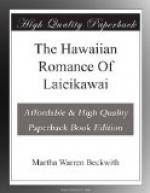[Footnote 72: According to the old Polynesian system of age groups, the “mother’s brother” bears the relation to the child of makua equally with his real parents. Kahalaomapuana says to her father:
“I am your child (kama),
The child of Laukieleula,
The child of Mokukelekahiki,
The child of Kaeloikamalama.”
thus claiming rank from all four sources. Owing to inbreeding and this multiple method of inheriting title, Polynesian children may be of higher rank than either parent. The form of colloquy which follows each encounter (compare Kila’s journey to Tahiti) is merely the customary salutation in meeting a stranger, according to Hawaiian etiquette.]
[Footnote 73: The name Laukieleula means “Red-kiele-leaf.” The kiele, Andrews says, is “a sweet-scented flower growing in the forest,” and is identified by some natives with the gardenia, of which there are two varieties native in Hawaii; but the form does not occur in any chants with which I am familiar. It is probably selected to express the idea of fragrance, which seems to be the kupua property of the mother’s side of the family. It is the rareness of fragrant plants indigenous to the islands, coupled with sensuous delight in odor, which gives to perfume the attributes of deity, and to those few varieties which possess distinct scent like the maile and hala, a conspicuous place in religious ceremonial.
The name of Moanalihaikawaokele, on the other hand, appears in the “Song of Creation,” in the eighth era where the generations of Uli are sung. In the time of calm is born the woman Lailai, and after her the gods Kii, Kane, and Kanaloa, and it is day. Then
“The drums are born,
Called Moanaliha,
Kawaomaaukele came next,
The last was Kupololiilialiimuaoloipo,
A man of long life and very high
rank.”
There follow 34 pages devoted to the history and generations of this family before the death of this last chief is recorded. Now it is clear that out of the first two names, Moanaliha and Kawao(maau)kele, is compounded that of the storm god. This would place him in the era of the gods as the father of Ku and ancestor of the Uli line.]
CHAPTER XXVIII
[Footnote 74: The story of the slaying of Halulu in the legend of Aukelenuiaiku is a close parallel to the Indian account of the adventure with the thunder bird. (See Matthews’s “Navajo legends.”) The thunder bird is often mentioned in Hawaiian chants. In the “Song of Creation” the last stanza of the third or bird era points out
“—the leaping point of
the bird Halulu,
Of Kiwaa, the bird of many notes,
And of those birds that fly close
together and shade the sun.”]




